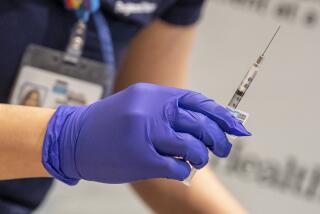Vaccine targets heart disease
Statin drugs may have revolutionized the treatment of heart disease by reducing artery-clogging bad cholesterol. But they’re not a cure-all.
These drugs target only one of the culprits behind heart attacks and strokes, and about half of all patients don’t take medications properly. But cardiovascular researchers say they may have found an answer to both problems -- an experimental vaccine that lowers risk in a different way while protecting people who sometimes forget to take a daily pill.
The vaccine aims to boost levels of the good cholesterol that prevents plaque from sticking to blood vessel walls.
Although several medications in development aim to raise this type of cholesterol, known as high-density lipoprotein, the vaccine is one of the few that has completed several tests in patients.
“It’s a very exciting area of investigation,” said Dr. Richard A. Stein, a spokesman for the American Heart Assn. “If they hold up, they would be a big home run and move us to the next step in preventing first and second heart attacks.”
The vaccine works by blocking CETP (cholesterol ester transfer protein), a protein that instigates the conversion of good HDL into bad LDL. “If you can prevent that transfer, then you can maintain higher levels of HDL,” said Charles Rittershaus, the scientist who devised the vaccine at Avant Immunotherapeutics in Needham, Mass. The advantage of a vaccine, which would be used in conjunction with current remedies, is that “it can provide longer-term protection and doesn’t require a daily pill where you worry that people stop taking their medications,” he added.
Because CETP is a naturally occurring protein, scientists had to figure out how to fool the body into thinking it was foreign. That way, the immune system would create antibodies to thwart its action.
Their strategy was to piggyback the protein onto a particle of tetanus toxin so that the body’s immune system would view the entire piece as alien, said Rittershaus, and would dispatch antibodies to fend off the supposed invader.
The tactic seems to have worked. In a 1994 study of rabbits who were fed a high-cholesterol diet, the HDL levels were 42% higher and LDL levels were 24% lower in the vaccinated group than in the unvaccinated group.
Since then, the vaccine has been tested in two separate studies on nearly 300 people. The results of the second phase of these tests should be released in the fall. (The first phase established dosing levels.)
If this research reveals that the vaccine elicits a similar response in humans, “it would be quite remarkable,” said Dr. Michael H. Davidson, a cardiologist at Rush Presbyterian-St. Luke’s Medical Center in Chicago, who has tested the vaccine. Statins raise HDL by only about 20%. “If it works, you’re talking about doubling the amount of HDL,” said Davidson, “which would make a tremendous reduction in cardiovascular risks.”
Several more years of tests are required before the vaccine can be approved for sale.
*
(BEGIN TEXT OF INFOBOX)
New weapons in the fight against heart disease
Several new medications may be able to lower heart disease risk as well. One experimental drug, made by Pfizer and called CP-529 or torcetrapib, also targets the CETP protein. Recent studies indicate that the oral medication, when taken with the statin Lipitor, can lower LDL by 60% and raise HDL by 50% after three months.
On other fronts, scientists at Cedars-Sinai Medical Center in Los Angeles, along with colleagues in Sweden, have devised a cholesterol-fighting vaccine that is designed to increase levels of immunoglobulin gamma G, an antibody that helps protect against heart disease. In studies of mice, immunization reduced atherosclerosis by about 60%. Researchers hope to begin human tests within the next two years.
Two niacin-based drugs that raise HDL are on the market: Niaspan, which was approved in 1997, and Advicor, a combination of Niaspan and Lovastatin, which became available earlier this year. Although effective, the drugs aren’t widely used because they cause temporary skin redness and flushing in some patients.





